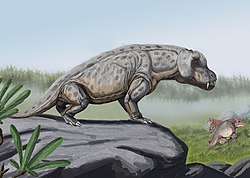Anteosauria
| Anteosaurs Temporal range: Middle Permian, 272–260 Ma |
|
|---|---|
 |
|
| Life restoration of Anteosaurus | |
| Scientific classification | |
| Kingdom: | Animalia |
| Phylum: | Chordata |
| Clade: | Synapsida |
| Order: | Therapsida |
| Suborder: | †Dinocephalia |
| Clade: | †Anteosauria |
| Subgroups | |
|
see Taxonomy |
|
| Synonyms | |
|
|
see Taxonomy
Anteosaurs are a group of large, primitive carnivorous dinocephalian therapsids with large canines and incisors and short limbs, that are known from the Middle Permian of South Africa, Russia, China, and Brazil. Some grew very large, with skulls 50–80 centimetres (20–31 in) long, and were the largest predators of their time. They died out at the end of the Middle Permian, possibly as a result of the extinction of the herbivorous Tapinocephalia on which they may have fed.
The Anteosauria are distinguished from the Tapinocephalia by a number of features, such as very large canines, cheek teeth with bulbous crowns, and an upturning of the premaxilla, so that the front of mouth curves strongly upwards. There is a tendencty especially in more advanced forms such as Anteosaurus towards thickening of the bones of the top of the skull, indicating head-butting behaviour. There is a large canal for the pineal organ (third eye); probably tied in with the animal's diurnal and seasonal cycles.
The shoulder girdle is fairly light, with a narrow interclavicle, clavicle, and scapular blade. The femur (thigh bone) is slender and curved. These were, in spite of their size, probably quite agile animals. The limbs are short and the skull long, narrow, and heavy. The tail is very long in at least some genera.
The early Russian (Boonstra 1972) and Chinese (Rubidge & Sidor 2001) anteosaurs are generally considered the most primitive of the dinocephalians, although it has also been suggested (Kemp, 1982, King 1988) that the estemmenosuchids are more basal. They have features in common with pelycosaurs (Carroll 1988) and Biarmosuchians (Chudinov 1965), and, with the Tapinocehalia, are part of the first major evolutionary radiation of the Therapsida (Rubidge & Sidor 2001). So far, little work has been done on detailed phylogenetic relationships between the various taxa.
...
Wikipedia
